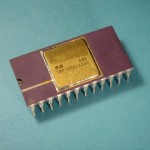General
|
General Information |
The National Semiconductor IMP-16 is actually a two chip implementation, it’s heart is being the IMP-00A.The National Semiconductor IMP-00A bit-slice microprocessor was introduced to market in the beginning of 1973, this is just the fourth microprocessor (1st, Intel 4004, 2nd Intel 8008, 3rd Rockwell PPS-4). The IMP-00A is the first bit-slice microprocessor, predating the Intel 3002 and AMD 2901. The IMP-00A was developed for the IMP series of minicomputers. The IMP-16 Minicomputer was implemented using 4 IMP-00A’s and a IMP-16A CROM.CPU devices are comprised on two major components the control unit (CU) and the arithmetic and logic unit (ALU). The CU controls the actions of the CPU and the ALU does the math and logic functions. Bit-slice microprocessors are CPU’s and have been split apart into CU and ALU functions. The IMP-00A is the ALU function. The CU can be implemented with custom circuitry, but a sequencing devices such as the IMP-16A is generally used to implement the CU.
National Semiconductor named the IMP-00A a RALU (Register and Arithmetic Logic Unit). The 4-bit IMP-00A was implemented using silicon gate PMOS technology and was clocked at about 700KHz. The IMP-00A had 7 4-bit registers, a status register, and 16 word stack. The IMP-00A could perform ADD, AND, OR, and XOR operations at a rate of about 1 million per second.To support the IMP-00A bit-slice processor, National Semiconductor created a CROM chip. The CROM function was to provide storage for the microprogram and control logic for the IMP-00A (this chip offered in separate auction). Together the CROM and IMP-00A RALU comprise a functional CPU. The IMP-16A CROM was used to implement the IMP minicomputer. The CROM can hold 100 microinstructions. National Semiconductor created 6 CROM’s with pre-defined instruction sets for use with IMP-00A. There were IMP-4A/521 (4-bit standard instruction set), IMP-8A/520 (8-bit standard instruction set), IMP-16A/521 (16-bit standard instruction set), and IMP-16A/522 (16-bit extended instruction set). These pre-defined instructions set were influenced by the Data General Nova minicomputer. |
|
Production |
1st Quarter 1973 |
| Designers | Unknown |
Architecture
| Type | Data Word | Address Space | Clock | Instruct- ions | Assists | Reg’s GP | Reg’s Math | Reg’s Index | IO Ports | Stack | Interrupts | Memory |
| Bit-slice, PMOS | 4-bit | 4K | 700Khz | NA | 4 | 4 | 4 | 2 Level |
Packages
|
Chip Name |
Package |
On-Chip Identification |
Picture |
General Comments |
| IMP-00A/520D | White ceramic, 28 Lead, CerDIP | |||
| IMP-00A/520D |
Red brown ceramic, 28 Lead, CerDIP |
|||
| IMP-4A/521 | ||||
| IMP-8A/520 | ||||
| IMP-16A/521 | ||||
| IMP-16A/522J | ||||
| IMP-16A/523 | ||||
| IMP-16A/524 |
Related Chips
|
Related Chips |
None |
|
Second Sources |
None |

